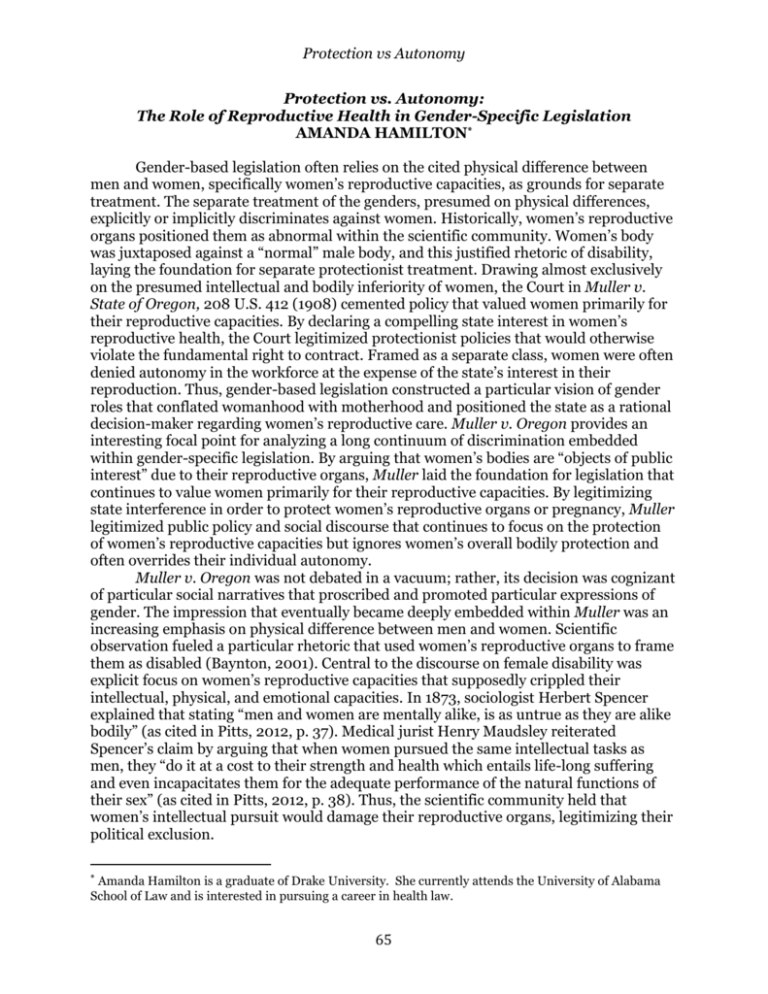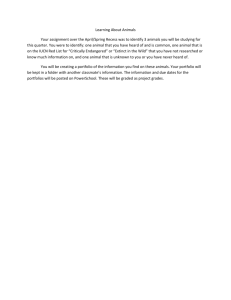DOC
advertisement

Protection vs Autonomy Protection vs. Autonomy: The Role of Reproductive Health in Gender-Specific Legislation AMANDA HAMILTON* Gender-based legislation often relies on the cited physical difference between men and women, specifically women’s reproductive capacities, as grounds for separate treatment. The separate treatment of the genders, presumed on physical differences, explicitly or implicitly discriminates against women. Historically, women’s reproductive organs positioned them as abnormal within the scientific community. Women’s body was juxtaposed against a “normal” male body, and this justified rhetoric of disability, laying the foundation for separate protectionist treatment. Drawing almost exclusively on the presumed intellectual and bodily inferiority of women, the Court in Muller v. State of Oregon, 208 U.S. 412 (1908) cemented policy that valued women primarily for their reproductive capacities. By declaring a compelling state interest in women’s reproductive health, the Court legitimized protectionist policies that would otherwise violate the fundamental right to contract. Framed as a separate class, women were often denied autonomy in the workforce at the expense of the state’s interest in their reproduction. Thus, gender-based legislation constructed a particular vision of gender roles that conflated womanhood with motherhood and positioned the state as a rational decision-maker regarding women’s reproductive care. Muller v. Oregon provides an interesting focal point for analyzing a long continuum of discrimination embedded within gender-specific legislation. By arguing that women’s bodies are “objects of public interest” due to their reproductive organs, Muller laid the foundation for legislation that continues to value women primarily for their reproductive capacities. By legitimizing state interference in order to protect women’s reproductive organs or pregnancy, Muller legitimized public policy and social discourse that continues to focus on the protection of women’s reproductive capacities but ignores women’s overall bodily protection and often overrides their individual autonomy. Muller v. Oregon was not debated in a vacuum; rather, its decision was cognizant of particular social narratives that proscribed and promoted particular expressions of gender. The impression that eventually became deeply embedded within Muller was an increasing emphasis on physical difference between men and women. Scientific observation fueled a particular rhetoric that used women’s reproductive organs to frame them as disabled (Baynton, 2001). Central to the discourse on female disability was explicit focus on women’s reproductive capacities that supposedly crippled their intellectual, physical, and emotional capacities. In 1873, sociologist Herbert Spencer explained that stating “men and women are mentally alike, is as untrue as they are alike bodily” (as cited in Pitts, 2012, p. 37). Medical jurist Henry Maudsley reiterated Spencer’s claim by arguing that when women pursued the same intellectual tasks as men, they “do it at a cost to their strength and health which entails life-long suffering and even incapacitates them for the adequate performance of the natural functions of their sex” (as cited in Pitts, 2012, p. 38). Thus, the scientific community held that women’s intellectual pursuit would damage their reproductive organs, legitimizing their political exclusion. * Amanda Hamilton is a graduate of Drake University. She currently attends the University of Alabama School of Law and is interested in pursuing a career in health law. 65 Ramapo Journal of Law and Society Relying on women’s supposed reproductive disabilities, those opposing women’s participation in the political arena via suffrage or education utilized social narratives that mandated discrimination based on disability. Juxtaposed against the male norm, women’s reproduction was constructed as a medical condition that mandated separate care (Baynton, 2001, p. 38). Justification for the denial of the same intellectual or political feats as men rested on the medical community’s argument that women’s psychological and emotional inferiority stemmed from their reproductive organs and these organs were in turn harmed by women’s attempts at equality. For example, in 1891, Dr. William Warren Potter, suggesting that women were made invalid by the “artificial cause” of education, argued “Her reproductive organs are dwarfed, deformed, weakened, and diseased by artificial causes imposed upon her during their development (Baynton, 2001, p. 38)”. The construction of women as disabled via their “abnormal” reproductive organs provided the justification for political exclusion. It legitimized and naturalized women’s positions in the home and to motherhood. In his article “Mental Differences between Men and Women,” George Romanes, a colleague of Charles Darwin, concluded “Women’s physical and mental differences precluded them from intellectual rigor and required their confinement to specific domestic and reproductive roles” (cited in Pitts, 2012, p. 41). By arguing that women’s natural role was in the home nurturing children, the medical community proscribed any activity that might threaten women’s ability to properly perform those functions. According to anti-suffragist Grace Duffield Goodwin, “In the carrying out of political plans…a woman will be at the mercy of her nature. For one whole year, if a new life is to emerge, she is unfit to assume additional risk or overstrain of her normally taxed nervous system. Where, then, is her surplus strength for the extra force to be expended in political excitements” (cited in Pitts, 2012, p. 52)? Goodwin contributed to the protectionist agenda that excluded women’s participation in politics. Muller v. Oregon arose in a social context that imagined all women as potential mothers and thus considered them unfit for political participation. Although women were eventually granted suffrage and various positions in the workforce, Muller’s reiteration of protectionist rhetoric illustrates how the conceptualization of women as disabled did not disappear. Rather, scientific claims and sociological “evidence” pointing to women’s supposed physical and intellectual deficiencies allowed the Court to view them as a separate class that needed protection from their own incompetency. Muller helped solidify the construction of reproductive disability by embedding it within constitutional law. The decision in Muller v. Oregon significantly broke with the Court’s precedential ruling in Lochner v. New York, 198 U.S. 45 (1905) where the Court declared labor contracts a fundamental right. The majority opinion in Lochner asserted that laws, which attempt to interfere with the fundamental right to contract, must demonstrate a compelling governmental interest. It further articulated that protection of workers’ health and safety was a legitimate reason for state interference. However, after accessing the facts of the case, the Court ruled the working conditions listed in Lochner didn’t pose a significant health risk: “We think that a law like the one before us involves neither the safety, morals, or welfare of the public, and that the interest of the public is not in the slightest degree affected by such an act” (Lochner v. New York, 1905, Protection vs Autonomy p.59). Therefore, the Court ruled that the state couldn’t regulate labor relations without violating a worker’s constitutional right to contract freely. Successively after Lochner, the Court in Muller v. Oregon (1908) cited women’s reproductive capacities as a health issue that the state could legitimately protect without violating women’s fundamental right to contract. The case drew upon the rhetoric of disability to address women’s physical vulnerabilities and suggested physical labor had detrimental effects on their reproductive capabilities (Sklar, 2004, p. 340). By illustrating protection of women’s reproductive health, the Court allowed the state, through gender-based legislation, to monitor women’s working conditions in ways that it legally did not for men. Muller v. Oregon focused on the specific perception of disabled childbearing women to construct safety provisions that would fulfill the state’s necessary and compelling interest in promoting maternal health. Thereby, it recognized that the state’s limitation of women’s work hours is not a violation of their fundamental right to contract. By allowing the state to intervene on women’s behalf, the Court articulated new protectionist rhetoric that emphasized the importance of women’s reproductive organs. Two key provisions listed in Muller explicitly illustrate the use of protectionist language. Drawing upon the rhetoric of disability, the Court argued that it was obvious that a “woman’s physical structure and the performance of maternal functions place her at a disadvantage in the struggle for subsistence is obvious” and the “physical well-being of women becomes an object of public interest and care in order to preserve the strength and vigor of the race” (Sklar, 2004, p. 341). Justifying the use of physical difference for gender-specific legislation, the Court stated: “The two sexes differ in structures of body, in the functions to be performed by each, in the amount of physical strength, in the capacity for long continued labor… this difference justifies a difference in legislation” (Sklar, 2004, p. 341). By focusing particularly on the protection of women’s reproductive capacity, the Court articulated a legitimate reason to treat women as a separate class. While the state ruled interference in men’s working conditions as a violation of the fundamental right to contract, the narrative of risk to women’s reproductive health overruled women’s autonomy in the workforce. Consequently, men were granted complete autonomy in the workforce and their role as breadwinner was naturalized. Through the conflation of women’s health and reproductive care, Muller implicitly recognized a particular understanding of gender roles that imagined all women as potential mothers and legitimized their role within the home. The Court thus reinforced the belief that women were destined primarily for motherhood. Protection of women’s reproductive health and their role within the home became a compelling state objective. Social welfare policies of the twentieth century focused on a specific mode of stability that normalized gendered work within the family; men were destined to become wage-earning fathers, and women were assumed to stay at home with the children and remain financially dependent on their husbands (Boris and Kleinberg, 2003, p.91). The bias against women was evident in the focus on “motherhood than mothers and caregivers than wage earners” (Boris and Kleinberg, 2003, p.91). Public health policies also followed the protectionist rhetoric articulated in Muller, as maternal health became the reference for women’s health, especially of women of childbearing age. In 1912, the Children’s Bureau was established to improve 67 Ramapo Journal of Law and Society living conditions of children in the United States; though originally instituted to focus on children’s issues, it eventually extended its objectives to prenatal advocacy and care (Waggoner, 2013, p. 350). During the early twentieth century, the bureau promoted a framework of preconception that women of childbearing age were “pre-pregnant”, and therefore, encouraged them to minimize health risks to protect current or future pregnancies (Waggoner, 2013, p. 347). Waggoner argues that the linkage of women’s health with maternal health occurred in a social policy environment that valued pregnancy and potential motherhood, one that exalted women as mothers and not women qua women” (Waggoner, 2013, p. 347). Protectionist policy in the workforce relied heavily on the conflation of women’s health and maternal health; women were considered delicate due to their reproductive organs and the law used precaution to legitimately limit or proscribe certain types of work for women. Although many jobs that present dangers to reproductive health involve other physical risks as well, gender-based legislation focuses exclusively on reproductive health, effectively using biological difference to disadvantage women (Norton, 1996, p. 2). For example, according to the National Institute for Occupational Safety and Health (NIOSH), approximately 20% of the 79,000 chemicals found in various workplaces pose risks to reproductive health (Norton, 1996, p. 2). Although these chemicals can harm reproductive structures and functions of both men and women, medical research has focused exclusively on maternal exposure (Norton, 1996, p. 2). Additionally, women are not actively protected from chemicals that pose health risks if they are unrelated to reproduction. Workplace restrictions and fetal protection laws are embedded with protectionist rhetoric that often denies women autonomy over decisions regarding work and reproduction. For example, although women of childbearing age were often prohibited from work that could damage their reproductive organs, men were not similarly protected or prevented from working in risky environments (Norton, 1996, p. 2). Rather, men are perceived as autonomous agents who have the capacity to weigh the costs and benefits of working in an environment that may pose risks to their reproductive health (Norton, 1996, p. 3). Conversely, women are repeatedly forced to surrender autonomy to the state’s claim over their reproductive proclivities. By defining all women of childbearing age as potential mothers, preconception health policy demands avoiding all risk to pregnancy or future pregnancy ( Waggoner, 2013, p. 345). Waggoner argues: “A distinctive feature of many of the enacted gender-specific public policies related to women’s health is a focus on maternity, that is, on the health of women as mothers or potential mothers” ( Waggoner, 2013, p. 345). Gender-based legislation uses protection as a justification to implement policy that often infringes women’s autonomy in the workforce. This is clear in Muller; the principles outlined by the Court suggest motherhood was women’s primary role and work came second. It remained silent about the potential economic repercussions gender-based legislation might impose upon women, including loss of work or wages. This suggests the Court assumed women, working or not, relied on men to provide real wages; the underlying idea being “women have always been dependent on men” (Norton, 1996, p. 3). The assumption that women rely on men for wages and could therefore afford not to work continues to permeate labor policies. Protectionist laws since the 1940’s have built on the premise that since women’s prime responsibility in the family is reproduction, it was justified to deny them income Protection vs Autonomy and job opportunities (Norton, 1996, p. 4). For example, some states prohibited women’s employment for a specific time frame before and after the birth of a child. Although disability insurance plans existed, they either excluded pregnancy altogether or provided reduced benefits for pregnant women (Norton, 1996, p. 3). These laws assumed that pregnant women could rely on their wage-earning husbands and simultaneously naturalized women’s primary role in the home. As legislators attempted to reform work environments to include women, protectionist rhetoric became persistent in defining what types of work were appropriate for women. The legal justification for exclusion of women often relied on the possibility of harm to reproductive health. During the 1970s, federal regulatory agencies pressured traditionally male-oriented, well-paid jobs to admit women. This mandate prompted a backlash in the form of fetal protection laws, where most women of childbearing age were entirely excluded from certain jobs or positions due to risk of “hazardous exposure” unless they could provide documented evidence of infertility (Norton, 1996, p. 5). Through his research of gender based legislations, including a survey of legislations in 1979, Norton demonstrates that more than 100,000 jobs were formally closed to women because employees provided evidence that these jobs posed a risk to women’s reproductive health (Norton, 1996, p. 5). Despite Title VII of the 1964 Civil Rights Act and the Pregnancy Discrimination Act of 1978, women’s autonomy in the workforce was often overruled by a more compelling interest in reproduction (Norton, 1996, p. 1). Women were not viewed as workers with a legitimate interest or claim to the fundamental right to work, due to the expectation that their primary role was of mothers. Additionally, women were often left without means to address their concerns. The protectionist rhetoric that legitimized separate treatment for women in Muller fueled the fetal protection debate that implicitly assumed female workers had no interest apart from reproduction or potential reproduction (Norton, 1996, p. 7). Constructed as a class without legitimate claims to work, women’s attempt to gain autonomy in the workforce is an uphill battle. For example, until the 1970s, women often struggled in segregated labor unions because they were not perceived as possessing the same right to work as men (Boris and Kleinberg, 2003, p. 96). The protectionist rhetoric that mandated separate treatment for women, based solely on reproductive capacity, continues to fuel the way we imagine women’s roles in society and legislate their positions in the workforce. The conflation of women’s health with maternal health suggests that women are valued primarily for their reproductive organs or fetuses, and jobs that suspend women’s autonomy in the name of fetal protection continue to ignore women’s physical and emotional health. Current Medicaid policies may deny coverage for women who are not pregnant but will not refuse services to those who are pregnant. As one obstetrician explained: “If you walked into my clinic and told me you’re pregnant, your services are covered. You have coverage instantaneously. Why? You’re pregnant. You know, you’re special” (Waggoner, 2013, p. p. 358). Such policies assume that women’s primary value and function lies in reproduction (Waggoner, 2013, p. 358). The construction of pregnancy as disability continues to fuel legislation that provides disability-like services to women who are pregnant or with young children but does not provide these same services to men. For example, many states have reserved parking spaces for pregnant women or women with newborns. However, this resource is 69 Ramapo Journal of Law and Society not available to new fathers. A lobbyist for the Women’s Health Organization illustrated the harm in this approach: “We’ve spent a long time trying to dispel the myth that pregnancy is a disability, for obvious reasons of discrimination. I have no problem with it being a courtesy, but not when a legislative mandate provides for pregnancy in the same way as for disabled persons” (Baynton, 2001, p. 42). Contemporary feminists argue that a more inclusive and just approach would frame fetal protection as a health and safety issue rather than a discrimination issue (Norton, 1996, p. 11). Perhaps this could be achieved by including a holistic approach to women’s health than only maternal health and by acknowledging men’s health as well. Drawing heavily on social discourse that framed women as disabled and thus incapable of autonomy in the workplace, Muller v. Oregon legitimized the use of gender-specific legislation to protect women’s reproduction. Muller’s decision established a clear difference between men and women’s autonomy: for men, the right to contract is a fundamental right; for women, the right to work is much narrower limited by consideration of interference with reproductive organs or pregnancy. Thus, Muller explicitly classified women as a separate class from men and legitimized their discrimination within the workforce. Subsequent legislation drew upon Muller’s protectionist principles and normalized a particular set of gender norms that placed men in the workforce and women at home. By arguing that women’s main function is reproduction, public policy and social discourse continue to focus on protecting women’s reproductive organs or pregnancy but ignore women’s overall health and autonomy. References: Baynton, Douglas C. (2001). “Disability and the Justification of Inequality in American History,” in Paul K. Longmore and Lauri Umansky ed. Disability History: American Perspectives. New York: New York University Press. Boris, Eileen and Kleinberg, S. J. (2003). “Mothers and Other Workers: (Re)Conceiving Labor, Maternalism, and the State”. Journal of Women’s History, 15 (3), pp. 90-117. Lochner v. New York, 198 U.S. 45 (1905). Muller v. State of Oregon, 208 U.S. 412 (1908). Norton, Sue M. (1996). “Jobs, Gender, and Foetal Protection Policies: From Muller v. Oregon to Johnson Controls,” Gender, Work, and Organization, 3(1), pp. 1-12. Pitts, Yvonne (2012). “Disability, Scientific Authority, and Women’s Political Participation at the Turn of the Twentieth-Century United States,” Journal of Women’s History, 24 (2), pp. 37-61. Sklar, Kathryn Kish (2004). “Document: Protecting Women Wage-Workers, Muller v. Oregon 1908”, in Women’s America, 6th ed. New York: Oxford University Press. Protection vs Autonomy Waggoner, Miranda R. (2013). “Motherhood Preconceived: The Emergence of the Preconception Health and Health Care Initiative”, Journal of Health Politics, Policy and Law, 38 (2), pp. 345-371. 71









